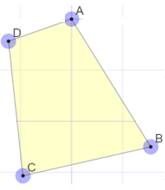5th Grade > Mathematics
MEASUREMENTS MCQs
Total Questions : 40
| Page 1 of 4 pages
Answer: Option B. -> multiply by 100
:
B
When we convert a larger unit (m) to a smaller unit (cm), we multiplyby the conversion factor.
Therefore, to convert length given in metres (m) to centimetres (cm) we have to multiply by 100.
:
B
When we convert a larger unit (m) to a smaller unit (cm), we multiplyby the conversion factor.
Therefore, to convert length given in metres (m) to centimetres (cm) we have to multiply by 100.
Answer: Option C. -> Spoon, Cup, Jug, Bucket
:
C
If we observe the picture, we see that the spoon is the smallest object which can hold the least quantity of liquid.
The cuphasmore capacity than the spoon.
The jug has more capacity than both the spoon and the cup.
The bucket can hold more liquid compared to the spoon, the cup and the jug.
:
C
If we observe the picture, we see that the spoon is the smallest object which can hold the least quantity of liquid.
The cuphasmore capacity than the spoon.
The jug has more capacity than both the spoon and the cup.
The bucket can hold more liquid compared to the spoon, the cup and the jug.
Answer: Option D. -> 400 mL
:
D
Capacity of 5 cups=2litres
When we convert a larger unit (L) to a smaller unit (mL), we multiply the given measure by powers of 10.
∴Capacity of 5 cups=2×1000mL(∵1litre=1000mL)
=2000mL
⇒Capacity of 1 cup=20005mL
=400mL
Thus, the capacity of 1 cup equals 400 mL.
:
D
Capacity of 5 cups=2litres
When we convert a larger unit (L) to a smaller unit (mL), we multiply the given measure by powers of 10.
∴Capacity of 5 cups=2×1000mL(∵1litre=1000mL)
=2000mL
⇒Capacity of 1 cup=20005mL
=400mL
Thus, the capacity of 1 cup equals 400 mL.
Answer: Option B. -> 700
:
B
We know that, 1 kg = 1000 g
We alreadyhave 300 g,
⇒1000 g - 300 g = 700 g
Therefore, 300 g + 700 g= 1000 g
:
B
We know that, 1 kg = 1000 g
We alreadyhave 300 g,
⇒1000 g - 300 g = 700 g
Therefore, 300 g + 700 g= 1000 g
Answer: Option A. -> 10 mm
:
A
String `A` is starting from 1 cm.
∴ Subtract 1 cm from 9 cm.
Lenght of string A
=9cm−1cm=8cm
String `B` is starting from 3 cm.
∴ Subtract 3 cm from 10 cm.
Length of string B
=10cm−3cm=7cm
Thus, the difference in length of String `A` and String `B`
=8cm−7cm=1cm=10mm
∴ Thelength of string A is morethan string B by 10 mm.
:
A
String `A` is starting from 1 cm.
∴ Subtract 1 cm from 9 cm.
Lenght of string A
=9cm−1cm=8cm
String `B` is starting from 3 cm.
∴ Subtract 3 cm from 10 cm.
Length of string B
=10cm−3cm=7cm
Thus, the difference in length of String `A` and String `B`
=8cm−7cm=1cm=10mm
∴ Thelength of string A is morethan string B by 10 mm.
Answer: Option B. -> Litre
:
B
'Litre' is the standard unit of capacity.
:
B
'Litre' is the standard unit of capacity.
Answer: Option D. -> 50 cm
:
D
We know that 1 m = 100 cm
Half a metre = 100 cm ÷ 2= 50 cm
:
D
We know that 1 m = 100 cm
Half a metre = 100 cm ÷ 2= 50 cm
Answer: Option C. -> 1000
:
C
The conversion factor for kilometre to metre is 1000.
When we convert a bigger unit (km) to a smaller unit (m), we multiply.
Therefore, 1 km = 1×1000 = 1000 m
:
C
The conversion factor for kilometre to metre is 1000.
When we convert a bigger unit (km) to a smaller unit (m), we multiply.
Therefore, 1 km = 1×1000 = 1000 m
Answer: Option B. -> Balance scale
:
B
Measuring tape is used to measure the length. For example the length of a cloth. Compass shows the direction. Measuring can is used to measure the volume of a liquid.
The balance scale is an instrument used to measure the mass. It is the device for weighing and find how much theobject weighs.
:
B
Measuring tape is used to measure the length. For example the length of a cloth. Compass shows the direction. Measuring can is used to measure the volume of a liquid.
The balance scale is an instrument used to measure the mass. It is the device for weighing and find how much theobject weighs.
Answer: Option A. -> 5 cm
:
A
If we observe the picture, the pencil on the scale is starting from1 cm. Ideally, it should start from zero. So, subtract 1 cm from 6 cm.
i.e., Length of the pencil =6cm−1cm=5cm
:
A
If we observe the picture, the pencil on the scale is starting from1 cm. Ideally, it should start from zero. So, subtract 1 cm from 6 cm.
i.e., Length of the pencil =6cm−1cm=5cm




















